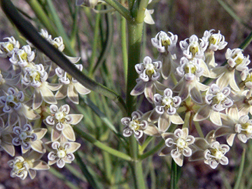Horsetail milkweed facts for kids
Quick facts for kids Horsetail Milkweed |
|
|---|---|
 |
|
| Scientific classification | |
| Kingdom: | |
| (unranked): | |
| (unranked): | |
| (unranked): | |
| Order: | |
| Family: | |
| Subfamily: |
Asclepiadoideae
|
| Genus: | |
| Species: |
A. amplexicaulis
|
| Binomial name | |
| Asclepias amplexicaulis (A. Gray) Vail
|
|
Asclepias subverticillata is a special kind of plant known as horsetail milkweed or whorled milkweed. It belongs to the milkweed family, which is famous for helping monarch butterflies. This plant is naturally found in the western parts of the United States.
Contents
What is Horsetail Milkweed?
Horsetail milkweed is a type of flowering plant. It is part of a large group of plants called Angiosperms, which means it produces flowers and seeds. This plant is also an eudicot, a common type of flowering plant.
Where Does it Grow?
This plant is native to the western United States. You can find it growing in many different states, including Arizona, California, Colorado, Kansas, Montana, Nebraska, Nevada, New Mexico, Oklahoma, South Dakota, Texas, Utah, and Wyoming. It often grows in dry, open areas like grasslands and deserts.
How Does it Look?
Horsetail milkweed gets its name because its leaves look a bit like a horse's tail. The leaves grow in groups, or "whorls," around the stem. This plant can grow to be about 1 to 3 feet (30 to 90 cm) tall. It has small, greenish-white flowers that grow in clusters. These flowers usually appear in the summer months.
Flowers and Seeds
The flowers of horsetail milkweed are small but important. They attract pollinators like bees and other insects. After the flowers are pollinated, they form seed pods. These pods are long and narrow. When they are ripe, they split open to release many flat, brown seeds. Each seed has a silky, white fluff attached to it. This fluff helps the wind carry the seeds far away.
Why is it Important?
Like other milkweeds, horsetail milkweed is very important for wildlife. It provides food and shelter for many creatures.
Monarch Butterflies
Milkweed plants are especially vital for monarch butterflies. Monarch caterpillars can only eat milkweed leaves. The leaves contain special chemicals that protect the caterpillars from predators. When the caterpillars eat the leaves, they store these chemicals in their bodies. This makes them taste bad to birds and other animals.
Other Wildlife
Besides monarchs, many other insects visit horsetail milkweed. Bees and other pollinators drink the nectar from its flowers. This helps the plant make seeds and also helps the insects find food. Birds and small mammals might also use the plant for shelter.
Uses by People
Historically, some Native Americans used parts of the horsetail milkweed plant. They sometimes used the fibers from the stems to make rope or cloth. The plant was also used in some traditional foods, but it's important to know that many milkweed species can be harmful if not prepared correctly.
Images for kids


